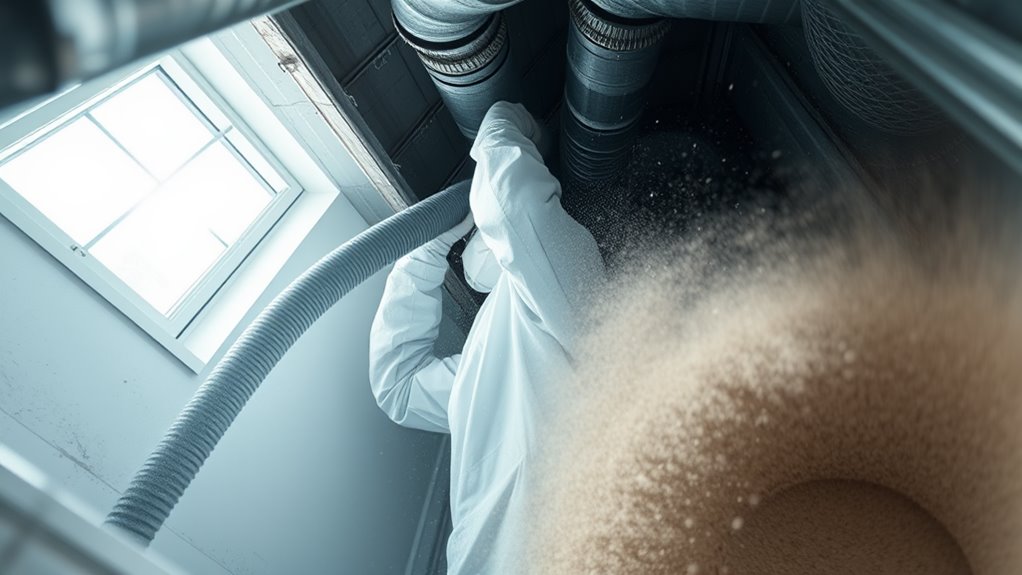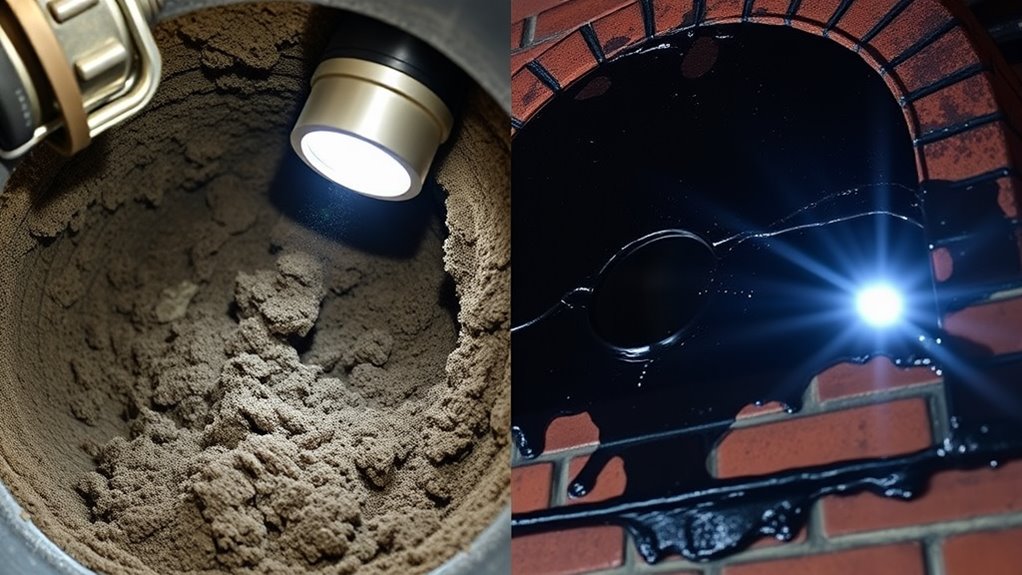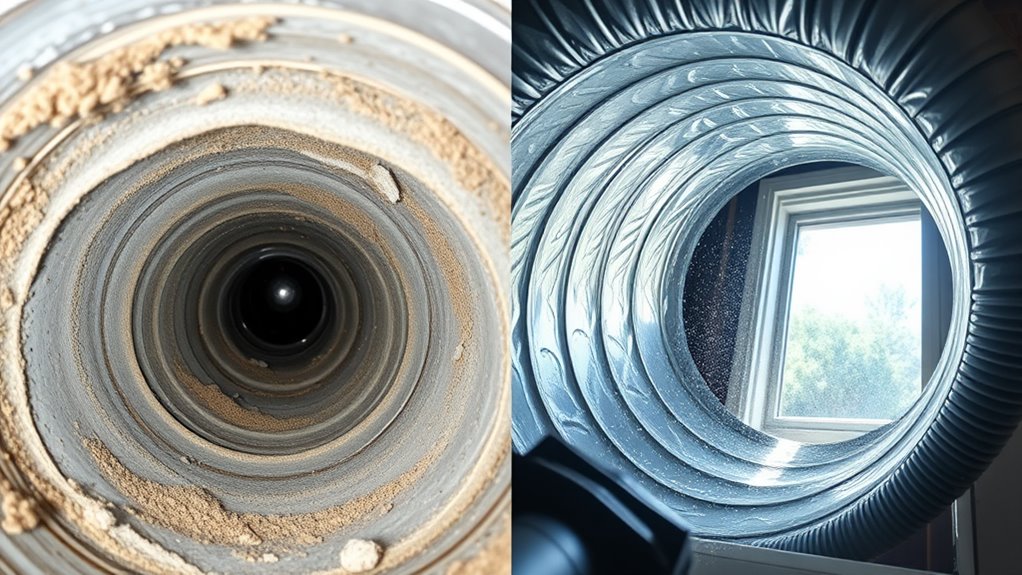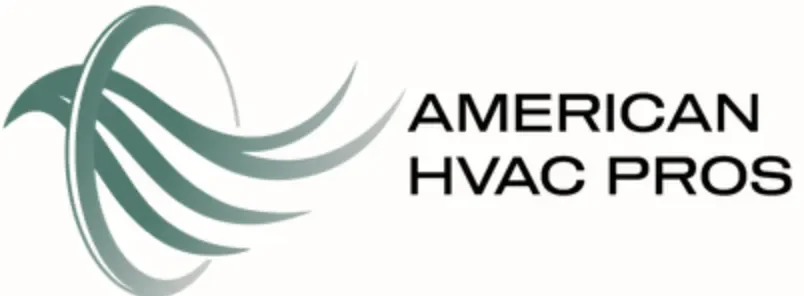Professional air duct and chimney cleaning services protect your home's air quality and safety. You'll need specialized equipment like HEPA vacuums and rotating brushes to remove harmful debris, allergens, and creosote buildup that can trigger respiratory issues and create fire hazards. Expect to pay $300-$1,000 for duct cleaning and $125-$350 for chimney cleaning. Choosing a NADCA or CSIA certified provider guarantees proper inspection, documentation, and thorough cleaning – essential steps in maintaining your home's ventilation systems.
Why Professional Duct and Chimney Cleaning Matters

While many homeowners overlook the maintenance of their air ducts and chimneys, these essential systems require regular professional cleaning to guarantee peak performance and safety. When you neglect these systems, they accumulate harmful debris, allergens, and combustion byproducts that can compromise your home's air quality and create fire hazards.
Professional cleaning offers significant benefits you can't achieve through DIY methods. Certified technicians use specialized equipment to remove deep-seated contaminants, soot, and creosote buildup from your ducts and chimneys. The importance of air quality can't be overstated, as clean systems reduce respiratory issues, allergies, and potential carbon monoxide exposure. You'll also benefit from improved heating efficiency, reduced energy costs, and extended system longevity through professional cleaning services that meet industry safety standards.
Signs Your Air Ducts Need Cleaning
Your air ducts need immediate attention when you notice visible dust and debris collecting around your vents or settling on nearby surfaces. A telltale indication of compromised ductwork is when you're consistently wiping away grey-black particles from furniture, even after regular cleaning. If you detect persistent musty odors circulating throughout your home when your HVAC system operates, your ductwork likely harbors accumulated debris, mold, or other contaminants requiring professional cleaning.
Visible Dust and Debris
Visible dust and debris accumulating around air vents serve as clear indicators that your ductwork requires professional cleaning. When you notice dark, fuzzy deposits or buildup around your registers, it's time to address the dust accumulation issue before it worsens.
You'll want to check these specific areas for visible signs:
- Supply and return air registers
- Vent covers and grilles
- Areas surrounding ductwork openings
- Interior surfaces of visible duct sections
- Basement or attic exposed ductwork
Perform a simple test by removing a vent cover and inspecting the interior with a flashlight. If you observe substantial debris buildup or can wipe visible dust from the ductwork's inner surfaces, schedule professional debris removal services. This inspection helps determine the extent of contamination and whether immediate cleaning is necessary.
Musty Odors Throughout Home
A persistent musty smell circulating through your home often indicates significant mold, mildew, or bacteria growth within the air duct system. When your HVAC system runs, it's distributing these unpleasant odors throughout every room, creating an unhealthy indoor environment.
Don't confuse temporary musty smell solutions, like air fresheners or deodorizers, with proper odor elimination techniques. These temporary fixes mask the underlying problem rather than addressing it. You'll need professional duct cleaning to remove the source of these odors, which typically includes sanitizing treatments that kill microorganisms and prevent their return.
If you're experiencing musty smells along with other symptoms like allergies or respiratory issues, it's essential to schedule an inspection immediately. Professional cleaners can identify the exact location and extent of contamination within your ductwork.
The Dangers of Neglected Chimneys

Failing to maintain your chimney can lead to severe safety hazards and structural damage. When creosote builds up inside your chimney's flue, it creates ideal conditions for dangerous chimney fires that can spread rapidly through your home. Regular maintenance helps prevent carbon monoxide poisoning by ensuring proper ventilation of combustion gases.
Regular chimney maintenance isn't optional – it's essential to prevent fires, structural damage, and deadly carbon monoxide buildup in your home.
Your neglected chimney can develop several critical issues:
- Cracked or deteriorating flue liner
- Blocked ventilation from debris and animal nests
- Corroded or loose chimney caps
- Damaged mortar joints and brickwork
- Creosote accumulation exceeding safe levels
You'll need professional inspection annually to identify these hazards before they become life-threatening. A certified chimney sweep can assess structural integrity, clear obstructions, and remove dangerous creosote deposits that put your home at risk.
The Air Duct Cleaning Process Explained
When you're ready to have your air ducts cleaned, a qualified technician will perform a thorough inspection using specialized cameras and diagnostic tools to assess your system's condition and contamination levels. Your technician will then assemble industrial-grade equipment including HEPA vacuums, rotating brushes, air whips, and compressed air tools to execute the cleaning. The multi-step cleaning process typically involves creating negative pressure with the vacuum system, dislodging debris with mechanical agitation tools, and collecting contaminants through the main vacuum line while maintaining proper containment throughout your HVAC system.
Initial Inspection and Assessment
Professional duct cleaning begins with a thorough visual inspection of your HVAC system and its components. During this initial inspection, technicians employ advanced assessment techniques to evaluate the condition of your ductwork and identify potential issues.
Your technician will examine:
- Access points and their locations throughout the system
- The extent of dust, debris, and possible contamination
- Signs of moisture, mold, or microbial growth
- Structural integrity of the ductwork, including seals and connections
- Presence of rodent or insect infestations
Using specialized inspection cameras and diagnostic tools, they'll document their findings and develop a detailed cleaning plan. This assessment helps determine the appropriate cleaning methods, equipment needed, and estimated time required for the job. It also reveals any repairs or modifications necessary before proceeding with the cleaning process.
Equipment and Tools Used
To effectively clean air ducts and chimneys, technicians rely on specialized equipment that combines powerful vacuum systems with mechanical agitation tools. You'll find that professional cleaning equipment includes truck-mounted vacuum collectors, high-powered HEPA filtration systems, and pneumatic agitation devices.
The specialized tools technicians use consist of rotating brushes, air whips, and compressed air nozzles that dislodge debris from your duct walls. They'll also employ video inspection cameras to assess hard-to-reach areas and verify cleaning results. For chimney cleaning, they'll use specialized brushes of different sizes, chemical cleaners for creosote removal, and extension rods to reach the entire flue length. All this equipment works together to guarantee thorough removal of contaminants from your ventilation system and chimney.
Multi-Step Cleaning Procedure
The air duct cleaning process follows a systematic, multi-step approach that guarantees thorough removal of contaminants throughout your HVAC system. You'll begin by implementing preventive measures, including covering furniture and sealing off vents not being cleaned.
The core cleaning procedure includes:
- Initial inspection and system assessment
- Creating negative pressure with professional vacuum equipment
- Mechanical brushing and agitation of duct surfaces
- Removal of dislodged debris and contaminants
- Final inspection and sanitization if required
Your cleaning frequency will depend on several factors, including household size, pets, and local environment. During the process, you'll notice technicians moving methodically from supply to return ducts, ensuring each section is thoroughly cleaned. They'll also clean your system's other components, including the air handler, registers, and grilles, to maintain peak airflow and system efficiency.
Essential Chimney Maintenance and Cleaning Steps
Regular maintenance and cleaning of your chimney system requires several critical steps to guarantee safe, efficient operation throughout the year. You'll need to schedule a professional chimney inspection at least annually, with more frequent checks if you use your fireplace heavily. The inspection will assess creosote buildup, structural integrity, and potential blockages.
You should determine your cleaning frequency based on how often you use your fireplace – typically, cleaning is necessary when creosote reaches 1/8 inch thickness. During cleaning, professionals will remove soot, creosote, and debris using specialized brushes and vacuum systems. They'll also check your chimney cap, crown, and flashing for damage. Don't forget to examine your damper's functionality and verify proper sealing. These steps help prevent chimney fires and maintain ideal ventilation.
Health Benefits of Clean Air Ducts and Chimneys

Maintaining clean air ducts and chimneys extends far beyond basic home maintenance – it directly impacts your family's respiratory health and general well-being. When you neglect these systems, they become breeding grounds for harmful contaminants that circulate throughout your home.
Clean ventilation systems safeguard your family's health. Neglected ducts and chimneys harbor contaminants that spread through your entire home.
Clean air ducts and chimneys provide these essential health safety benefits:
- Reduced exposure to allergens, dust mites, and pet dander
- Decreased risk of respiratory infections and asthma attacks
- Prevention of carbon monoxide poisoning from blocked chimneys
- Elimination of musty odors and airborne bacteria
- Lower risk of mold-related health issues
Your home's air quality markedly improves when you maintain clean ventilation systems. You'll notice fewer respiratory symptoms, reduced allergy flare-ups, and better overall indoor air circulation. Regular cleaning also prevents the accumulation of harmful substances that could compromise your family's long-term health.
Cost Factors and Service Expectations
While costs for air duct and chimney cleaning services can vary considerably, several key factors influence the final price you'll pay. The size of your home, number of vents, system accessibility, and level of contamination directly impact the cost breakdown. You'll typically find service packages ranging from $300 to $1,000 for extensive duct cleaning, while chimney cleaning often runs between $125 to $350 per visit.
You should expect a thorough inspection before any cleaning begins, detailed documentation of problem areas, and a complete system cleaning that includes main trunk lines, return vents, and supply registers. Most service packages also include sanitization, deodorizing, and a final inspection. Reputable companies will provide written estimates and guarantee their work, ensuring you know exactly what you're paying for.
Choosing the Right Cleaning Service Provider
Selecting a qualified air duct and chimney cleaning service requires careful evaluation of several critical criteria. You'll need to verify the company's service reputation through customer reviews and confirm they meet industry standards for professional cleaning.
When evaluating potential service providers, consider these essential factors:
- NADCA or CSIA certification that confirms technical expertise
- Length of time in business and local presence
- Insurance coverage and liability protection
- Detailed written estimates and service guarantees
- Specialized equipment and cleaning methodologies
You should request documentation of their licensing, examine their safety protocols, and verify their business credentials through your local Better Business Bureau. Ask for references from recent customers and inquire about their quality control processes to confirm consistent, professional service delivery.
Maintenance Tips to Extend Time Between Cleanings
Once you've secured a professional cleaning service, you can implement several preventive measures to optimize the time between professional cleanings. Begin your DIY maintenance routine by regularly changing HVAC filters every 60-90 days, or monthly during peak usage seasons. Install high-quality filters rated MERV 8 or higher to capture more particulates.
Perform seasonal checks of your ductwork and chimney systems. Inspect visible ducts for signs of damage, seal any leaks with metal-backed tape, and vacuum vent covers. For chimneys, check the cap's condition, remove visible debris, and verify the damper operates smoothly. Keep outdoor units clear of leaves and vegetation, and consider installing programmable thermostats to reduce system strain. Don't forget to monitor humidity levels and address moisture issues promptly to prevent mold growth.
Frequently Asked Questions
Can I Clean My Air Ducts and Chimney Myself Using Household Tools?
While you can attempt DIY techniques for basic maintenance, professional cleaning tools and expertise are essential for thorough duct and chimney cleaning. You'll risk damaging components or incomplete cleaning with household tools. For ducts, you'd need specialized vacuum systems and rotary brushes. For chimneys, you'll face dangerous creosote buildup that requires professional-grade equipment. Both systems need precise methods to prevent debris circulation and safety hazards.
How Long Does a Typical Air Duct and Chimney Cleaning Service Take?
You'll typically spend 2-3 hours for a complete air duct duration, as technicians need to access all vents, main trunk lines, and return ducts. For chimney service time, expect 45-60 minutes for a standard cleaning. However, these timeframes can vary based on your home's size, system complexity, and level of buildup. If both services are performed together, you're looking at approximately 3-4 hours total for thorough completion.
Are There Specific Seasons When Duct and Chimney Cleaning Is Recommended?
You'll want to schedule air duct cleaning during spring maintenance, when winter's accumulated dust and debris can be removed before running your AC system. For chimneys, late summer or early fall is ideal for winter preparation, confirming your fireplace is safe before the heating season begins. You'll benefit from cleaner air in spring and summer, while fall cleaning prevents dangerous creosote buildup and confirms proper ventilation for winter heating.
Will Cleaning Services Damage My Wallpaper or Interior Decorations?
Professional cleaning services won't damage your wallpaper or decorations when proper precautions are taken. Your technician will use wallpaper protection measures, including drop cloths and specialized equipment covers, to guarantee interior safety. They'll seal off work areas and use vacuum systems with controlled suction power. You'll notice they follow methodical cleaning protocols, maintaining a safe distance between cleaning tools and your walls to prevent any contact or damage.
Can Birds or Animals Be Removed During Chimney Cleaning Service?
Yes, you'll find that professional chimney services include bird removal and animal extraction procedures. They'll use specialized equipment and techniques to safely remove nests, birds, squirrels, raccoons, or other creatures that have taken residence in your chimney. They'll also install proper caps and screens after the removal to prevent future infestations. It is crucial to let professionals handle this task as they're trained to deal with wildlife humanely and safely.

